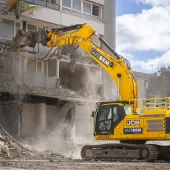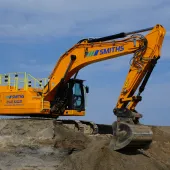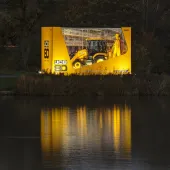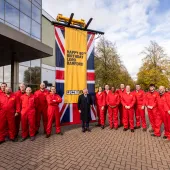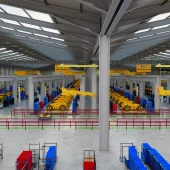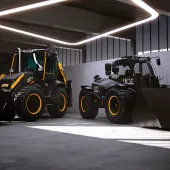JCB Mark 70 years in Business
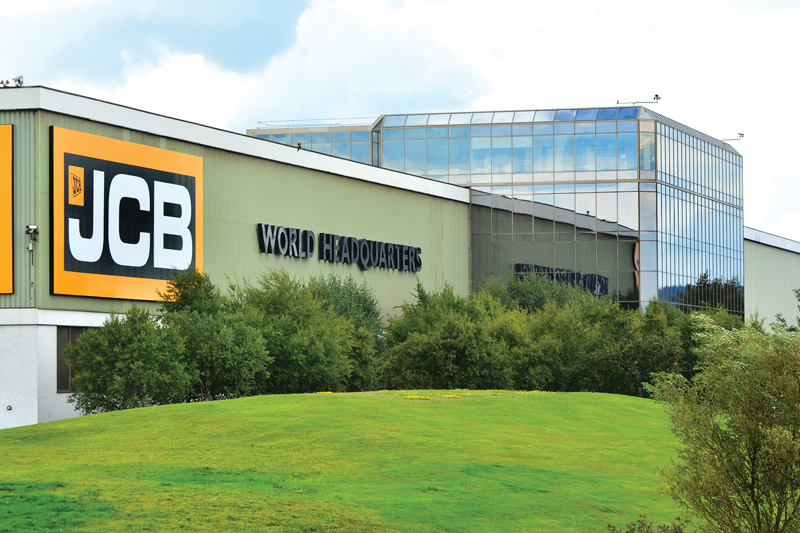
First published in the December 2015 issue of Quarry Management as Seven Decades of Success
From a Uttoxeter garage to a global force – JCB mark 70 years in business
JCB were founded on 23 October 1945 by the late Joseph Cyril Bamford in a tiny lock-up garage in the Staffordshire market town of Uttoxeter. It was the same day that his son Anthony, now Lord Bamford, was born, and as Mr Bamford once remarked ‘being presented with a son tended to concentrate the mind, and when you were starting at the bottom, there was only one way to go and that was up’.
The foundation for the growth that was to follow was the manufacture of a tipping trailer made out of war-time scrap and which today stands proudly in the showroom of JCB’s World HQ. It was produced in Mr Bamford’s garage and sold for £45 at the town’s market. The buyer’s old cart, which was taken in part-exchange, was refurbished by Mr Bamford and sold for another £45.
By 1947 the company was expanding and moved a few miles down the road to a stable block at Crakemarsh Hall, which was owned by Julia Cavendish, a survivor of the Titanic disaster. At this time JCB also took on their first-ever full-time employee, Arthur Harrison, who became foreman.
By 1950 JCB were on the move again, this time to the site of a former cheese factory in Rocester, a location identified by Bill Hirst. Now aged 83 and living in Uttoxeter, Mr Hirst joined JCB in 1947 at the age of 15 as a £1-a-week teaboy and subsequently rose through the ranks to become service director.
1953 proved to be a pivotal year for new products when Mr Bamford invented the backhoe loader with the launch of the JCB Mk 1 excavator – the first time a single machine had been produced with a hydraulic rear excavator and front-mounted shovel. This ingenuity still bears fruit today: JCB have manufactured more than 600,000 backhoes and they are now made on three continents. 1953 was also the year that the famous JCB logo was first used on a machine; it was eventually registered as a trademark five years later.
By the 1960s it was clear the backhoe loader was revolutionizing the building industry, increasing productivity and reducing reliance on manpower. As the new decade dawned, the company was also harnessing new tools to generate business and promote the brand. In 1961 JCB Aviation were formed and the company’s first-ever plane, a twin-engine de Havilland Dove, made its inaugural flight, with customers from Europe now able to make a return visit to the factory in a single day.
It was in 1962 that JCB’s first-ever overseas subsidiary in Holland was opened. A year later the JCB 3C backhoe, an acknowledged design classic, was launched. Such was the growing success of the company that in 1964, with sales up by 60% to £8 million, employees shared in a £250,000 bonus. The news made national headlines and payouts were on such a scale that some employees were able to buy their first homes with the bonus they received. Mr Bamford declared: ‘I am giving you this money because I want you to share in the success of the company you have helped make.’ In the same year, JCB exported their first-ever machine to the US – a JCB 4C backhoe loader.
In 1969 JCB produced a record 4,500 machines and by now were exporting more than half of them. It was in recognition of this export success that the company received, in this year, its first-ever Queen’s Award – the first of 27 such accolades. It was also the year Mr Bamford became a Commander of the British Empire (CBE) in honour of the company’s export achievements.
As 1970 dawned JCB opened for business in the US, setting up a base in Whitemarsh, Baltimore, to harness the huge growth opportunity that North America offered. Between 1971 and 1973 the company’s turnover doubled to £40 million. In 1975 JCB’s founder retired, telling staff in a farewell message that his son, Anthony, faced the tough job of moving JCB forward through the next decades into a new century. ‘This is a demanding task but he has been well trained for it and is supported by a very strong team from works staff to management,’ he said. ‘There cannot be any limit to the successes.’
Dawn of a new era
And so a new era had dawned – one that would see huge expansion of both manufacturing facilities and product ranges. It started in 1972 with the opening of JCB France. In 1977 the wraps came off the Loadall telescopic handler, a machine which revolutionized the way loads are handled and has gone on to be one of the most successful products in JCB’s history. 1977 also marked the start of a number of high-profile visits to JCB by members of the British royal family, when HRH The Prince of Wales toured the Rocester factory. A year later another landmark was achieved with the construction of JCB’s second factory in the UK, JCB Transmissions in Wrexham, North Wales.
It was the decision to start manufacturing in India in 1979, however, that heralded a period of global expansion as Anthony Bamford spotted the potential of this market. Today JCB have factories in New Delhi, Pune and Jaipur, and India is now the company’s biggest market after the UK.
Product innovation continued to be the lifeblood of the company and in 1985 the 3CX Sitemaster backhoe loader was launched and went on to be JCB’s biggest-selling backhoe. It was also the year JCB celebrated the production of their 100,000th backhoe. In 1987 Prime Minister Margaret Thatcher toured JCB’s World HQ and drove a machine off the production line in front of ecstatic crowds. A year later the wraps came off the 100 miles/h JCB GT backhoe – a promotional tool that continues to draw the crowds wherever it appears around the world.
By 1990 JCB were expanding into new ‘fields’ with the launch of the JCB Fastrac tractor – the world’s first genuine high-speed, full-suspension tractor. It cost £12 million to develop and took the world of agriculture by storm. This was also the year that Anthony Bamford received his knighthood and became Sir Anthony, an honour he said ‘recognized the efforts of the whole JCB team’. To celebrate, JCB employees were given an extra day’s holiday.
Product development continued unabated with the launch of the 2CX backhoe loader in 1990, followed three years later by the even smaller 1CX. In 1995 JCB celebrated their 50th anniversary with a visit by HM The Queen to their World HQ, where she unveiled a replica of the Uttoxeter garage where Mr Bamford began his business all those years ago.
Future Labour Prime Minister Tony Blair visited in 1996 and helped assemble a 4CX, and in 1997 the innovative Teletruk forklift – which can lift and place loads over obstacles – was launched. In 1998 JCB opened their second factory in Wrexham, followed a year later by the opening of JCB Earthmovers in Cheadle, Staffordshire. In 2000 the first machines began rolling off the production line at JCB’s new North American headquarters in Savannah, Georgia.
End of an era
On 1 March 2001, flags at JCB factories around the world flew at half-mast following news of the death of the company’s founder, Joseph Cyril Bamford. Britain’s Financial Times newspaper said he was blessed with a rare combination of ‘engineering genius and marketing flair’.
In 2004 employees gathered at the World HQ in Rocester for a commemorative photo to mark the production of the 500,000th machine. It had taken just short of 60 years to reach this milestone. The next half million machines would be produced in the next nine years. 2004 was also the year that JCB entered the world of engine production with the launch of the Dieselmax engine, manufactured at JCB Power Systems in Derbyshire.
In 2005 JCB opened their factory in Pudong, China, and announced news of the biggest-ever order in their history, a $140 million deal to supply the US Army with a high-speed backhoe loader for military engineering tasks. The following year Sir Anthony Bamford’s son Jo became a director of JCB – the third generation of the Bamford family to hold such a position. 2006 was also the year that saw JCB set a world record with the JCB Dieselmax streamliner car. Powered by two JCB Dieselmax engines, it reached a fraction over 350 miles/h on the Bonneville Salt Flats in the US to attain the record of ‘world’s fastest diesel car’, a title it still holds today.
2007 was the year that JCB achieved their highest-ever machine sales of 72,000 units, while in 2008 JCB Heavy Products – which manufactures tracked and wheeled excavators – moved to a brand new factory on the outskirts of Uttoxeter. This was followed a year later by a £40 million investment in JCB’s factory in Ballabgarh, India, to create the world’s biggest backhoe loader factory. Also in 2009, HRH Prince William followed in his father’s footsteps of 32 years earlier when he toured the company’s headquarters and helped employees celebrate the production of the 750,000th machine.
A national shortage of engineers inspired Lord Bamford to establish the JCB Academy in Rocester, Staffordshire, in 2010, to train the country’s engineers and business leaders of the future. The facility has been a resounding success with nearly 1,000 students passing through its doors, all of whom have gone on to employment or further education. In 2010 JCB also announced a US$40 million project to develop a brand new range of skid-steer and tracked loaders, to be manufactured at their North American HQ.
Looking ahead
As they looked to the future, JCB also celebrated their heritage with the opening of the ‘Story of JCB’ in 2011, a permanent exhibition marking the growth of JCB and the Bamford family’s roots in industry – roots that can be traced back almost 200 years to when they started out as blacksmiths in Uttoxeter,
before founding agricultural machinery suppliers Bamfords Ltd in the town in 1871.
Global manufacturing extended to Brazil in 2012 and British Prime Minister David Cameron officially opened the new £63 million facility in Sao Paulo state. In this year JCB also celebrated the securing of a £60 million order for more than 1,000 backhoes from the Brazilian Government.
As JCB approached their 68th birthday in 2013, an independent economic report revealed the company supported 24,000 jobs in the UK and contributed £545 million to the British Exchequer. Hundreds of employees also gathered outside the World HQ for a commemorative photograph marking the production of the one millionth JCB machine. 2013 was also a momentous year for JCB’s chairman as he became Lord Bamford, after being invited by Prime Minister David Cameron to be a Conservative working peer in the House of Lords.
Last year production started at JCB’s new £62 million Jaipur factory complex, in India, and plans were announced for a £20 million new HQ for JCB Germany in Cologne.
Earlier this year, as JCB prepared to mark their 70th anniversary, the wraps came off the brand new 3CX Compact backhoe loader, a machine 35% smaller than its bigger brother and designed to work on increasingly congested building sites. Then, to mark their 70th anniversary on 23 October 2015, JCB gave their 12,000+ employees at 22 factories around the world an extra day’s holiday, and launched a limited-edition version of their most famous machine, the 3CX backhoe loader. A total of 70 of these special machines will be made with red buckets, full white cab and red wheels – a striking livery last seen nearly 40 years ago on the JCB 3CIII model.
Speaking on the company’s 70th anniversary, Lord Bamford said JCB employees should be very proud of what had been achieved over the past 70 years – but that the company’s focus was very much on the future. ‘Seventy years is a long time, but the past is the past and while we are proud of it, our engineers are really only interested in the future and the products of tomorrow,’ he said. ‘You cannot rest on your laurels in business; you have to be thinking of tomorrow, the changing world markets and the products our customers need. That is what makes me and all our people tick.’
- Subscribe to Quarry Management, the monthly journal for the mineral products industry, to read articles before they appear on Agg-Net.com


